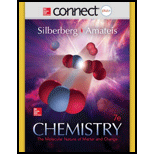
Interpretation:
The difference between intensive and extensive properties is to be determined.
Concept introduction:
The physical properties of the system are classified as follows:
1. Intensive properties: These depend on the nature of the substance.
2. Extensive properties: These depend on the amount of substance.
(a)
Interpretation:
Whether mass is an intensive or extensive property is to be determined.
Concept introduction:
The intensive properties are the properties that depend on the nature of the substance. It is independent of the size of the system. It remains the same if the system is further divided into a number of subsystems. Temperature, refractive index, and density are some of the examples of intensive properties.
The extensive properties are the properties that depend on the amount of substance. It is additive if the system is divided into a number of subsystems. Mass, color, energy, and volume are some examples of extensive properties.
(b)
Interpretation:
Whether density is an intensive or extensive property is to be determined.
Concept introduction:
The intensive properties are the properties that depend on the nature of the substance. It is independent of the size of the system. It remains the same if the system is further divided into a number of subsystems. Temperature, refractive index, and density are some of the examples of intensive properties.
The extensive properties are the properties that depend on the amount of substance. It is additive if the system is divided into a number of subsystems. Mass, color, energy, and volume are some examples of extensive properties.
(c)
Interpretation:
Whether the volume is an intensive or extensive property is to be determined.
Concept introduction:
The intensive properties are the properties that depend on the nature of the substance. It is independent of the size of the system. It remains the same if the system is further divided into a number of subsystems. Temperature, refractive index, and density are some of the examples of intensive properties.
The extensive properties are the properties that depend on the amount of substance. It is additive if the system is divided into a number of subsystems. Mass, color, energy, and volume are some examples of extensive properties.
(d)
Interpretation:
Whether the melting point is an intensive or extensive property is to be determined.
Concept introduction:
The intensive properties are the properties that depend on the nature of the substance. It is independent of the size of the system. It remains the same if the system is further divided into a number of subsystems. Temperature, refractive index, and density are some of the examples of intensive properties.
The extensive properties are the properties that depend on the amount of substance. It is additive if the system is divided into a number of subsystems. Mass, color, energy, and volume are some examples of extensive properties.
Want to see the full answer?
Check out a sample textbook solution
Chapter 1 Solutions
Connect 2-Year Access Card for Chemistry: The Molecular Nature of Matter and Change
- Identify any polar covalent bonds in epichlorohydrin with S+ and 8- symbols in the appropriate locations. Choose the correct answer below. Η H's+ 6Η Η Η Η Η Ηδ Η Ο Ο HH +Η Η +Η Η Η -8+ CIarrow_forwardH H:O::::H H H HH H::O:D:D:H HH HH H:O:D:D:H .. HH H:O:D:D:H H H Select the correct Lewis dot structure for the following compound: CH3CH2OHarrow_forwardRank the following compounds in order of decreasing boiling point. ннннн -С-С-Н . н-с- ННННН H ΗΤΗ НННН TTTĪ н-с-с-с-с-о-н НННН НН C' Н н-с-с-с-с-н НН || Ш НННН H-C-C-C-C-N-H ННННН IVarrow_forward
- Rank the following compounds in order of decreasing dipole moment. |>||>||| ||>|||>| |>|||>|| |||>||>| O ||>>||| H F H F H c=c || H c=c F F IIIarrow_forwardchoose the description that best describes the geometry for the following charged species ch3-arrow_forwardWhy isn't the ketone in this compound converted to an acetal or hemiacetal by the alcohol and acid?arrow_forward
- What is the approximate bond angle around the nitrogen atom? HNH H Harrow_forwardOH 1. NaOCH2CH3 Q 2. CH3CH2Br (1 equiv) H3O+ Select to Draw 1. NaOCH2 CH3 2. CH3Br (1 equiv) heat Select to Edit Select to Drawarrow_forwardComplete and balance the following half-reaction in acidic solution. Be sure to include the proper phases for all species within the reaction. S₂O₃²⁻(aq) → S₄O₆²⁻(aq)arrow_forward
- Q Select to Edit NH3 (CH3)2CHCI (1 equiv) AICI 3 Select to Draw cat. H2SO4 SO3 (1 equiv) HO SOCl2 pyridine Select to Edit >arrow_forwardComplete and balance the following half-reaction in basic solution. Be sure to include the proper phases for all species within the reaction. Zn(s) → Zn(OH)₄²⁻(aq)arrow_forwardb. ὋΗ CH3CH2OH H2SO4arrow_forward
 ChemistryChemistryISBN:9781305957404Author:Steven S. Zumdahl, Susan A. Zumdahl, Donald J. DeCostePublisher:Cengage Learning
ChemistryChemistryISBN:9781305957404Author:Steven S. Zumdahl, Susan A. Zumdahl, Donald J. DeCostePublisher:Cengage Learning ChemistryChemistryISBN:9781259911156Author:Raymond Chang Dr., Jason Overby ProfessorPublisher:McGraw-Hill Education
ChemistryChemistryISBN:9781259911156Author:Raymond Chang Dr., Jason Overby ProfessorPublisher:McGraw-Hill Education Principles of Instrumental AnalysisChemistryISBN:9781305577213Author:Douglas A. Skoog, F. James Holler, Stanley R. CrouchPublisher:Cengage Learning
Principles of Instrumental AnalysisChemistryISBN:9781305577213Author:Douglas A. Skoog, F. James Holler, Stanley R. CrouchPublisher:Cengage Learning Organic ChemistryChemistryISBN:9780078021558Author:Janice Gorzynski Smith Dr.Publisher:McGraw-Hill Education
Organic ChemistryChemistryISBN:9780078021558Author:Janice Gorzynski Smith Dr.Publisher:McGraw-Hill Education Chemistry: Principles and ReactionsChemistryISBN:9781305079373Author:William L. Masterton, Cecile N. HurleyPublisher:Cengage Learning
Chemistry: Principles and ReactionsChemistryISBN:9781305079373Author:William L. Masterton, Cecile N. HurleyPublisher:Cengage Learning Elementary Principles of Chemical Processes, Bind...ChemistryISBN:9781118431221Author:Richard M. Felder, Ronald W. Rousseau, Lisa G. BullardPublisher:WILEY
Elementary Principles of Chemical Processes, Bind...ChemistryISBN:9781118431221Author:Richard M. Felder, Ronald W. Rousseau, Lisa G. BullardPublisher:WILEY





